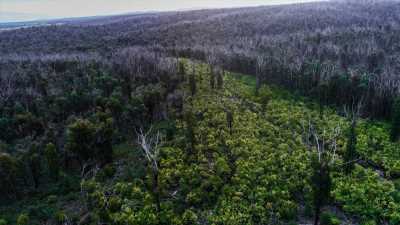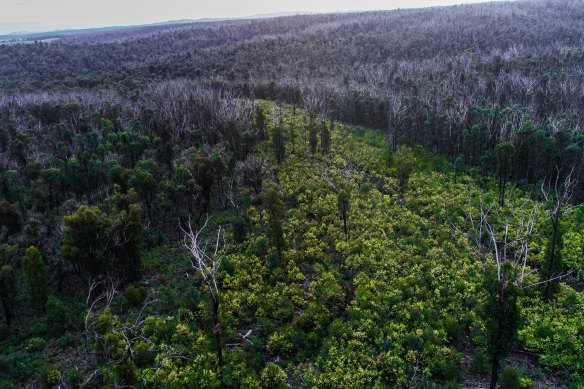Save articles for later
Add articles to your saved list and come back to them any time.
The Victorian government’s announcement last week that it will end native forest logging in the state next year has accelerated debate about the future of the industry elsewhere, particularly in NSW, and given rise to the prospect of greater federal government engagement on a nationally significant issue.
The Andrews government’s surprise decision – delivered as part of its state budget package last Tuesday – to bring forward its planned native logging shutdown from 2030 to January 1, 2024, has provoked strong responses.
A native timber forest on the outskirts of Orbost which was partially logged three years ago after a bushfire.Credit: Joe Armao
For conservationists and environmental scientists it has been celebrated, although noted as “long overdue”. For unions representing forestry workers and for members of communities sustained by the industry, it is a betrayal by a government that has acted “recklessly, heartlessly and unilaterally”.
The multiple and competing pressures at play have long made native forest logging a challenging proposition for governments. The survival of fragile biodiversity and ecological systems, and the related survival of the planet, is cast against the survival of an ailing industry, and the impact its disappearance might have on the livelihoods of the people and towns that depend on it. There is fragility in the natural, political and social environments.
Victoria’s decision is a bold one made near the start of an election cycle by a government chipping away at a mountain of debt, whose native forest harvesting business has long been a huge drain on the public purse. It follows a path laid in Western Australia in 2021 by the freshly re-elected Labor government, which announced it would end native forest logging by 2024.
WA premier Mark McGowan pledged $350 million to expand the plantation-based softwood industry and promised $80 million to assist businesses affected by the closure, but WA timber workers complained they were blindsided by the two-year timeframe, were not given enough information to adapt operations and would be run out of business.
The fast-tracked decision by the Victorian government gives forestry workers and their communities, who thought they had six more years to make the transition to closure, little more than six months to establish new livelihoods. “I don’t know what we’re going to do, I don’t know the answer yet,” Vince Hurley, the chief executive of Australian Sustainable Hardwoods, told The Age.
The Andrews government says it is alive to these concerns, and an extra $200 million in the budget brought its commitment to worker support services and investments for the transition to plantation timber to more than $875 million. It will provide support vouchers of up $25,000 for “highly impacted” businesses, and businesses can apply for grants of up to $120,000 “to execute business model transformation”.
It is critical that these funds are well delivered in communities that are already some of the state’s most under-privileged, many of which are also affected by the closure of nearby coal mines and power stations. Effective delivery must include exploiting the potential for future jobs involved in bushfire mitigation and firefighting, the strategic restoration of damaged native forests, control of feral animals, tourism and carbon sequestration.
The NSW government will have a keen interest in the implementation and impacts of the Victorian ban, which has already brought calls for NSW’s new environment minister, Penny Sharpe, to follow suit. The Minns Labor government would face similar backlash from forestry communities north of the Murray River, but some political cover for such a move arrived from an unexpected source this week. A report by the outgoing Perrottet government last October, revealed by The Guardian, found that native logging could be ended in NSW with no cost to the budget, and only rejection from the Nationals stopped the Liberals adopting a ban.
It was further evidence of the weak business case in native forest logging. In Victoria, VicForests has been propped up financially by the state government for years and in the past financial year alone it recorded a $54 million loss and took a loan of $80 million. A report by the conservative Blueprint Institute found that a shutdown of native forest logging in Victoria’s Central Highlands in 2022-23 would have brought a $59 million benefit to the state.
Blueprint similarly found that the logging of native forest on the North Coast of NSW was not financially viable, and the NSW Greens note that the industry has lost $30 million in the state in the past two years.
Concerns that the embattled housing industry would be robbed of valuable supplies of hardwood do not stack up. A startling 86 per cent of precious native forests are felled for low-end products such as woodchips, paper pulp and box liners. About 80 per cent of the type of sawn timber used for housing comes from plantations.
ANU professor David Lindenmayer, one of the world’s leading forest ecology experts, notes that “preserving our native forests is worth much more in carbon storage, water production and tourism than they ever were as woodchips”.
Lindenmayer notes that areas that were slated for logging in Victoria provide habitat for more than 50 threatened and rare species. He says that bringing forward the end of logging is “equal to removing 730,000 petrol of diesel cars from our roads every year”.
If NSW was seeking further encouragement to follow Victoria and WA, it might be found in a vow this week from federal Environment Minister Tanya Plibersek. In keeping with its emissions targets and its fight against the extinction of native species, the Albanese government has made a welcome commitment to bring regional forest agreements under new national environment standards.
The Age welcomes moves to protect the environment, the economy and the communities affected by all these changes. They will bring fresh challenges and require ongoing focus from all involved to avoid perverse outcomes or unnecessary problems.
Patrick Elligett sends an exclusive newsletter to subscribers each week. Sign up to receive his Note from the Editor.
Most Viewed in National
From our partners
Source: Read Full Article


